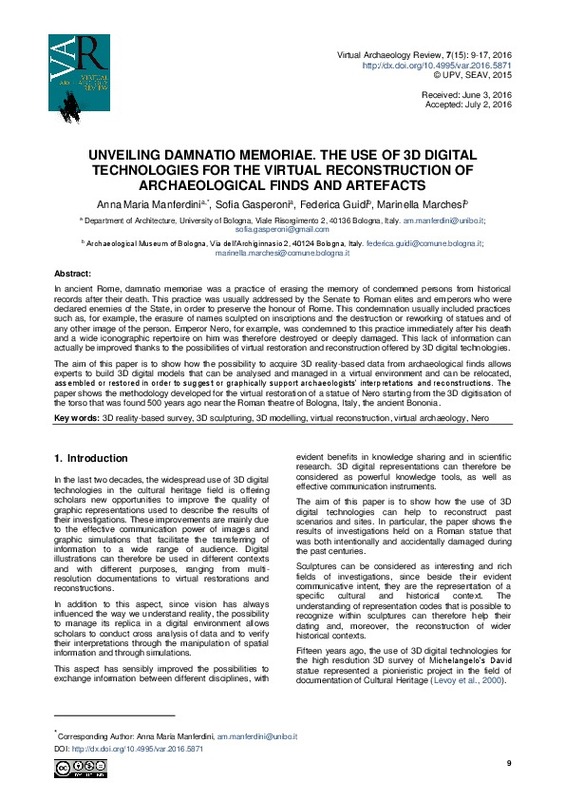JavaScript is disabled for your browser. Some features of this site may not work without it.
Buscar en RiuNet
Listar
Mi cuenta
Estadísticas
Ayuda RiuNet
Admin. UPV
Unveiling Damnatio Memoriae. The use of 3D digital technologies for the virtual reconstruction of archaeological finds and artefacts
Mostrar el registro sencillo del ítem
Ficheros en el ítem
| dc.contributor.author | Manferdini, Anna Maria
|
es_ES |
| dc.contributor.author | Gasperoni, Sofia
|
es_ES |
| dc.contributor.author | Guidi, Federica
|
es_ES |
| dc.contributor.author | Marchesi, Marinella
|
es_ES |
| dc.date.accessioned | 2017-05-05T10:02:15Z | |
| dc.date.available | 2017-05-05T10:02:15Z | |
| dc.date.issued | 2016-11-15 | |
| dc.identifier.uri | http://hdl.handle.net/10251/80652 | |
| dc.description.abstract | [EN] In ancient Rome, damnatio memoriae was a practice of erasing the memory of condemned persons from historical records after their death. This practice was usually addressed by the Senate to Roman elites and emperors who were declared enemies of the State, in order to preserve the honour of Rome. This condemnation usually included practices such as, for example, the erasure of names sculpted on inscriptions and the destruction or reworking of statues and of any other image of the person. Emperor Nero, for example, was condemned to this practice immediately after his death and a wide iconographic repertoire on him was therefore destroyed or deeply damaged. This lack of information can actually be improved thanks to the possibilities of virtual restoration and reconstruction offered by 3D digital technologies.The aim of this paper is to show how the possibility to acquire 3D reality-based data from archaeological finds allows to build 3D digital models that can be analysed and managed in a virtual environment and can be relocated, assembled or restored in order to suggest or graphically support archaeologists’ interpretations and reconstructions. The paper shows the methodology developed for the virtual restoration of the statue of Nero starting from the 3D digitization of the torso that was found 500 years ago by the Roman theatre of Bologna, Italy, the ancient Bononia. | es_ES |
| dc.language | Inglés | es_ES |
| dc.publisher | Universitat Politècnica de València | |
| dc.relation.ispartof | Virtual Archaeology Review | |
| dc.rights | Reconocimiento - No comercial - Sin obra derivada (by-nc-nd) | es_ES |
| dc.subject | 3D reality-based survey | es_ES |
| dc.subject | 3D sculpturing | es_ES |
| dc.subject | 3D modelling | es_ES |
| dc.subject | Virtual reconstruction | es_ES |
| dc.subject | Virtual archaeology | es_ES |
| dc.subject | Nero | es_ES |
| dc.title | Unveiling Damnatio Memoriae. The use of 3D digital technologies for the virtual reconstruction of archaeological finds and artefacts | es_ES |
| dc.type | Artículo | es_ES |
| dc.date.updated | 2017-05-05T09:50:22Z | |
| dc.identifier.doi | 10.4995/var.2016.5871 | |
| dc.rights.accessRights | Abierto | es_ES |
| dc.description.bibliographicCitation | Manferdini, AM.; Gasperoni, S.; Guidi, F.; Marchesi, M. (2016). Unveiling Damnatio Memoriae. The use of 3D digital technologies for the virtual reconstruction of archaeological finds and artefacts. Virtual Archaeology Review. 7(15):9-17. https://doi.org/10.4995/var.2016.5871 | es_ES |
| dc.description.accrualMethod | SWORD | es_ES |
| dc.relation.publisherversion | https://doi.org/10.4995/var.2016.5871 | es_ES |
| dc.description.upvformatpinicio | 9 | es_ES |
| dc.description.upvformatpfin | 17 | es_ES |
| dc.type.version | info:eu-repo/semantics/publishedVersion | es_ES |
| dc.description.volume | 7 | |
| dc.description.issue | 15 | |
| dc.identifier.eissn | 1989-9947 |








